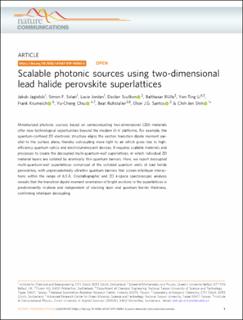Please use this identifier to cite or link to this item:
https://doi.org/10.21256/zhaw-19629| Publication type: | Article in scientific journal |
| Type of review: | Peer review (publication) |
| Title: | Scalable photonic sources using two-dimensional lead halide perovskite superlattices |
| Authors: | Jagielski, Jakub Solari, Simon F. Jordan, Lucie Scullion, Declan Blülle, Balthasar Li, Yen-Ting Krumeich, Frank Chiu, Yu-Cheng Ruhstaller, Beat Santos, Elton J. G. Shih, Chih-Jen |
| et. al: | No |
| DOI: | 10.1038/s41467-019-14084-3 10.21256/zhaw-19629 |
| Published in: | Nature Communications |
| Volume(Issue): | 11 |
| Issue: | 1 |
| Issue Date: | Jan-2020 |
| Publisher / Ed. Institution: | Nature Publishing Group |
| ISSN: | 2041-1723 |
| Language: | English |
| Subject (DDC): | 530: Physics |
| Abstract: | Miniaturized photonic sources based on semiconducting two-dimensional (2D) materials offer new technological opportunities beyond the modern III-V platforms. For example, the quantum-confined 2D electronic structure aligns the exciton transition dipole moment parallel to the surface plane, thereby outcoupling more light to air which gives rise to high-efficiency quantum optics and electroluminescent devices. It requires scalable materials and processes to create the decoupled multi-quantum-well superlattices, in which individual 2D material layers are isolated by atomically thin quantum barriers. Here, we report decoupled multi-quantum-well superlattices comprised of the colloidal quantum wells of lead halide perovskites, with unprecedentedly ultrathin quantum barriers that screen interlayer interactions within the range of 6.5 Å. Crystallographic and 2D k-space spectroscopic analysis reveals that the transition dipole moment orientation of bright excitons in the superlattices is predominantly in-plane and independent of stacking layer and quantum barrier thickness, confirming interlayer decoupling. |
| URI: | https://digitalcollection.zhaw.ch/handle/11475/19629 |
| Fulltext version: | Published version |
| License (according to publishing contract): | CC BY 4.0: Attribution 4.0 International |
| Departement: | School of Engineering |
| Organisational Unit: | Institute of Computational Physics (ICP) |
| Appears in collections: | Publikationen School of Engineering |
Files in This Item:
| File | Description | Size | Format | |
|---|---|---|---|---|
| 2020_Jagielski_Scalable_photonic_sources_using_two-dimensional_lead_halide_perovskite_superlattices_Nature_Communications.pdf | 3.01 MB | Adobe PDF |  View/Open |
Show full item record
Jagielski, J., Solari, S. F., Jordan, L., Scullion, D., Blülle, B., Li, Y.-T., Krumeich, F., Chiu, Y.-C., Ruhstaller, B., Santos, E. J. G., & Shih, C.-J. (2020). Scalable photonic sources using two-dimensional lead halide perovskite superlattices. Nature Communications, 11(1). https://doi.org/10.1038/s41467-019-14084-3
Jagielski, J. et al. (2020) ‘Scalable photonic sources using two-dimensional lead halide perovskite superlattices’, Nature Communications, 11(1). Available at: https://doi.org/10.1038/s41467-019-14084-3.
J. Jagielski et al., “Scalable photonic sources using two-dimensional lead halide perovskite superlattices,” Nature Communications, vol. 11, no. 1, Jan. 2020, doi: 10.1038/s41467-019-14084-3.
JAGIELSKI, Jakub, Simon F. SOLARI, Lucie JORDAN, Declan SCULLION, Balthasar BLÜLLE, Yen-Ting LI, Frank KRUMEICH, Yu-Cheng CHIU, Beat RUHSTALLER, Elton J. G. SANTOS und Chih-Jen SHIH, 2020. Scalable photonic sources using two-dimensional lead halide perovskite superlattices. Nature Communications. Januar 2020. Bd. 11, Nr. 1. DOI 10.1038/s41467-019-14084-3
Jagielski, Jakub, Simon F. Solari, Lucie Jordan, Declan Scullion, Balthasar Blülle, Yen-Ting Li, Frank Krumeich, et al. 2020. “Scalable Photonic Sources Using Two-Dimensional Lead Halide Perovskite Superlattices.” Nature Communications 11 (1). https://doi.org/10.1038/s41467-019-14084-3.
Jagielski, Jakub, et al. “Scalable Photonic Sources Using Two-Dimensional Lead Halide Perovskite Superlattices.” Nature Communications, vol. 11, no. 1, Jan. 2020, https://doi.org/10.1038/s41467-019-14084-3.
Items in DSpace are protected by copyright, with all rights reserved, unless otherwise indicated.